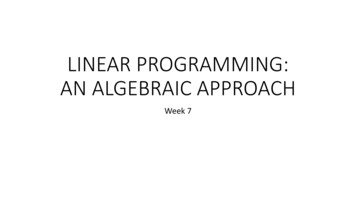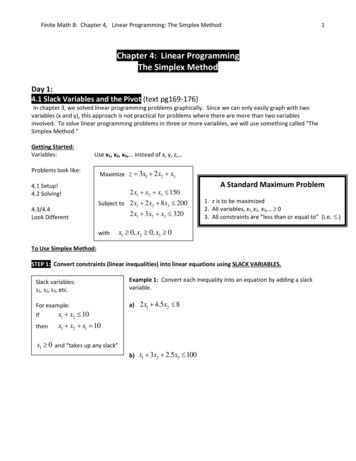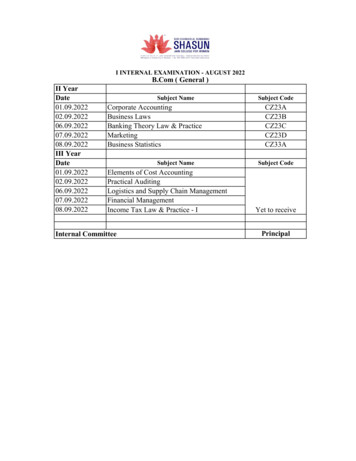
Transcription
Catlike Coding › Unity › Tutorials › Pseudorandom Surfacespublished 2022-08-30Simplex DerivativesAnalytical Normals and TangentsAdd derivative data to noise samples.Derive tangents and normals from derivatives.Calculate derivatives for simplex noise.Create a smooth turbulence variant.This is the second tutorial in a series about pseudorandom surfaces. In it we will calculatederivatives of simplex noise and use them to generate normal and tangent vectors.This tutorial is made with Unity 2020.3.35f1.Rotated 3D smooth turbulence simplex noise with analytical normal vectors.
1Simplex NoiseWe can ask Unity to recalculate normal and tangent vectors, but this isn't a perfectapproach. Recalculation requires a complete mesh and thus has to wait until all Burst jobshave finished and takes place on the main thread. Also, recalculating tangents requires UVcoordinates and takes a long time.It would be much better if normals and tangents could be generated directly by SurfaceJob.This is possible by relying on the derivatives of the noise function, so we're going tocalculate those derivatives ourselves. As simplex noise has the simplest derivatives we'llbegin with that noise type.1.1Noise ConfigurationWe'll work our way up from one to three dimensions, and also from the simpler simplexvalue noise to the more complex simplex gradient noise. Let's reintroduce a noise selectionconfiguration option for this, like we made in the Pseudorandom Noise series.Create a SurfaceJobScheduleDelegate type for the SurfaceJob.ScheduleParallel method. As itdoesn't belong to a specific noise type it must exist outside the generic SurfaceJob so let'sput it directly below it in the same file.public struct SurfaceJob N : IJobFor where N : struct, INoise { }public delegate JobHandle SurfaceJobScheduleDelegate (Mesh.MeshData meshData, int resolution, Settings settings, SpaceTRS domain,float displacement, JobHandle dependency);Before we add a second static jobs array to ProceduralSurface refactor rename the jobs arrayto meshJobs for clarity.static AdvancedMeshJobScheduleDelegate[] meshJobs { };Then add a two-dimensional array of surface job delegates for all three dimensions ofregular simplex and simplex value noise, along with a noise type and dimensionsconfiguration option, matching the apporach used in the Pseudorandom Noise series.
static SurfaceJobScheduleDelegate[,] surfaceJobs {{SurfaceJob Simplex1D Simplex .ScheduleParallel,SurfaceJob Simplex2D Simplex .ScheduleParallel,SurfaceJob Simplex3D Simplex .ScheduleParallel},{SurfaceJob Simplex1D Value .ScheduleParallel,SurfaceJob Simplex2D Value .ScheduleParallel,SurfaceJob Simplex3D Value .ScheduleParallel}};public enum NoiseType {Simplex, SimplexValue}[SerializeField]NoiseType noiseType;[SerializeField, Range(1, 3)]int dimensions 1;Configuration for noise type and dimensions.Now adjust GenerateMesh so it schedules the configured surface job.//SurfaceJob Lattice2D LatticeNormal, Perlin .ScheduleParallel(surfaceJobs[(int)noiseType, dimensions - 1](meshData, resolution, noiseSettings, domain, displacement,meshJobs[(int)meshType](mesh, meshData, resolution, default,new Vector3(0f, Mathf.Abs(displacement)), true)).Complete();2D simplex noise; frequency 4.
2Noise Derivative DataIn order to work with the derivatives of the noise we have to change our noise code so itprovides this data along with the noise values.2.1Vectorized Noise SampleEach time we sample the noise function we get a value. Now we also want to get the valueof the derivatives of that function. But a single derivative value isn't enough, because ournoise function can have up to three dimensions, and thus the noise function could have aderivative is each of those dimensions. So each noise sample must contain four values, allof which are vectorized. We'll introduce a new Noise.Sample4 struct type for this, which weput in a new Noise.Sample partial class asset file in the Noise folder. Begin by onlyincluding a field for the sample value that we already provide, simply naming it v for value.using Unity.Mathematics;using static Unity.Mathematics.math;public static partial class Noise {public struct Sample4 {public float4 v;}}Let's give it an implicit cast operator from float4 to Sample4, simply passing along the value.This makes sense because the derivative of a constant is zero.public static implicit operator Sample4 (float4 v) new Sample4 { v v };
2.2Interface AdjustmentNow we can upgrade our noise by changing the return type of INoise.GetNoise4 to Sample4.public interface INoise {Sample4 GetNoise4 (float4x3 positions, SmallXXHash4 hash, int frequency);}We also have to change the implementations of this method to match. I only show thisonce, but it has to be done for all INoise lining)]public Sample4 GetNoise4(float4x3 positions, SmallXXHash4 hash, int frequency) { }This change will result in compiler errors where GetNoise4 is invoked. Fix these by accessingthe value of the sample. .GetNoise4( ).v 2.3Derivative DataLet's now expand our Sample4 data to also include the derivatives. If there were only a singlederivative function then we could su!ce with adding a single extra field, which we couldname dv, standing for the delta of the value, indicating how fast it changes.public float4 v, dv;But because our noise can vary in up to three dimensions there are three such values. We'llname them dx, dy, and dz.public float4 v, dx, dy, dz;2.4Derivative MathWe already know that the derivatives of values can be added just like the values themselves.Mathematically, we can say if f(x) g(x) h(x) then f' (x) g' (x) h' (x).Thus we have a well-defined addition for our Sample4 type, so let's give it a custom additionoperator method.
public staticv a.v dx a.dxdy a.dydz a.dz};Sample4 operator (Sample4 a, Sample4 b) new Sample4 {b.v, b.dx, b.dy, b.dzAnd the same goes for subtraction.public staticv a.v dx a.dxdy a.dydz a.dz};Sample4 operator - (Sample4 a, Sample4 b) new Sample4 {b.v,- b.dx,- b.dy,- b.dzScaling also applies to the derivative normally. We can see this mathematically via2f(x) f(x) f(x) thus (2f(x))' f' (x) f' (x) 2f' (x).So let's add multiplication methods for Sample4 and float4 operands and the other wayaround.public staticv a.v *dx a.dxdy a.dydz a.dz};Sample4 operator * (Sample4 a, float4 b) new Sample4 {b,* b,* b,* bpublic static Sample4 operator * (float4 a, Sample4 b) b * a;And let's also add a method to support division by a float4, becausepublic staticv a.v /dx a.dxdy a.dydz a.dz};f(x)1 f(x).22Sample4 operator / (Sample4 a, float4 b) new Sample4 {b,/ b,/ b,/ bWe won't add an operator for division with a sample, nor for sample-sample multiplication,because those are more complicated and not something that we currently need.2.5Fractal Noise MethodWe currently have two jobs that both contain code for a fractal noise loop. Let's consolidatethem into a single static generic Noise.GetFractalNoise method that returns the fractalsample. Use the relevant code from SurfaceJob.Execute.
using System;using System.Runtime.CompilerServices; public static partial class Noise { public interface INoise {Sample4 GetNoise4 (float4x3 positions, SmallXXHash4 hash, int veInlining)]public static Sample4 GetFractalNoise N (float4x3 position, Settings settings) where N : struct, INoise {//float4x3 position );var hash SmallXXHash4.Seed(settings.seed);int frequency settings.frequency;float amplitude 1f, amplitudeSum 0f;float4 sum 0f;for (int o 0; o settings.octaves; o ) {sum amplitude * default(N).GetNoise4(position, hash o, frequency).v;amplitudeSum amplitude;frequency * settings.lacunarity;amplitude * settings.persistence;}//noise[i] sum / amplitudeSum;return sum / amplitudeSum;} }Noise.Job.Executecan then be reduced to a single assignment.public void Execute (int i) noise[i] GetFractalNoise N )), settings).v;And SurfaceJob.Execute can also be simplified.public void Execute (int i) {Vertex4 v vertices[i];// float4 noise GetFractalNoise N 0.position, v.v1.position, v.v2.position, v.v3.position))),settings).v * displacement;//noise * displacement;v.v0.position.y v.v1.position.y v.v2.position.y v.v3.position.y vertices[i] v;}noise.x;noise.y;noise.z;noise.w;
Now we can make GetFractalSum return a proper sample by changing the type of the sumand accumulating the entire samples.Sample4 sum default;for (int o 0; o settings.octaves; o ) {sum amplitude * default(N).GetNoise4(position, hash o, frequency); //.v;amplitudeSum amplitude;frequency * settings.lacunarity;amplitude * settings.persistence;}Adjust the type of noise in SurfaceJob.Execute as well.Sample4 noise GetFractalNoise N ( ) * displacement; //.v * sition.yv.v3.position.y noise.v.x;noise.v.y;noise.v.z;noise.v.w;
2.6Analytical TangentsThe tangent vectors of the mesh can be derived for the analytical noise derivatives of the Xdimension. The X derivative represents the rate of change per unit along X. As we use thenoise to o"set the Y position this derivative represents the elevation change. Thus we havea 2D vector t [1] where dx is the X derivative, which we can expand to a tangentdxvector. Let's initially do this only for the first out of four vertices.v.v3.position.y noise.v.w;v.v0.tangent float4(1f, noise.dx.x, 0f, -1f);vertices[i] v;To make this a proper tangent vector it has to be normalized. Explicitly for our vector, t [11]. If we extract the normalizer factor we can directly use it for the Xdx dx2 1component of the vector.float4 normalizer rsqrt(noise.dx * noise.dx 1f);float4 tangentY noise.dx * normalizer;v.v0.tangent float4(normalizer.x, tangentY.x, 0f, -1f);Expand this approach to set the tangents of all four tangent ;-1f);If we disable the recalculation options of our procedural mesh we'll now see it use tangentvectors derived from analytical derivatives instead of a mesh-based approximation. Butbecause all derivative data is still zero at this point all tangent vectors will be flat.
31D DerivativesWe begin with 1D noise so we only have to worry about a single dimension.3.1Simplex Value NoiseLet's initially consider simplex value noise. Because its gradient is a constant value andderivatives can be added, we only have to consider the individual kernel fallo" function3f(x) (1 x2 ) scaled by some value that is constant per kernel. Adjust Simplex1D.Kernelso it returns this as a Sample4. Use (1 x2 ) as the base function and raise it to the thirdpower and scale it when setting the sample value.static Sample4 Kernel (SmallXXHash4 hash, float4 lx, float4x3 positions) {float4 x positions.c0 - lx;float4 f 1f - x * x;//f f * f * f;float4 g default(G).Evaluate(hash, x);return new Sample4 {v f * f * f * g};}2By applying the chain rule we find f' (x) 6 x(1 x2 ) . Use that to set the X derivative,also scaling it by the same gradient, which we consider to be constant.return new Sample4 {v f * f * f * g,dx f * f * -6f * x * g};What's the chain rule?f(x) g(h(x)) then f' (x) g' (h(x))h' (x). What thismeans is that we can treat h(x) as if it were simply x for the purpose of finding the derivativeof f(x), but afterwards we have to replace x with h(x) and multiply the result with h' (x).The chain rule states that ifg(x) x2 and h(x) 3 x. If we treat h(x) as if it were simply x thenf' (x) 2x. However, after that we have to replace x with h(x), so we getf' (x) 2h(x) 6 x. Then we also have to multiply that with h' (x) 3 which leads tof' (x) 18 x.An example isWe can verify that this is correct by rewriting2f(x) g(h(x)) g(3 x) (3 x) 9 x2 ,which has the same derivative.Note that a trivial example is any function where we replaceidentity function. Asx with h(x) x, which is theh' (x) 1 multiplying with it makes no di"erence.
How did you find that derivative?Using the chain rule, declare2f(x) g(x)3whereg(x) 1 x2 . Then22f' (x) 3 g(x) g' (x) 3 g(x) ( 2x) 6 xg(x) 6 x(1 x2 )Note that2.g(x) is a substitution function and does not refer to the constant value g, which isignored here.Also, in section 1.3 of Pseudorandom Noise / Simplex Noise we found thatf' (x) 6 x5 12x3 6 x 6 x(x4 2x2 1) 6 x(1 x2 )2.At this point we again get a compilation error, because EvaluateCombined expects a float4argument. Change the IGradient.EvaluateCombined interface method declaration so it acts ona Sample4 instead.Sample4 EvaluateCombined (Sample4 value);Adjust all the gradient implementations to match. This is trivial for all gradients except theTurbulencevariant.public Sample4 EvaluateCombined (Sample4 value) value;Turbulencetakes the absolute value of the noise. We'll deal with this later, simply passthrough the unadjusted sample for now.public Sample4 EvaluateCombined (Sample4 value) G).EvaluateCombined(value);Incorrect tangents; simplex value noise; frequency 4.
We finally get to see analytical tangent vectors. However, they are incorrect unless thefrequency is set to 1. This happens because the frequency acts like a scalar for the rate ofchange of the noise. E"ectively, if the frequency is set to 4 we're using f(g(x)) withg(x) 4 x and have to apply the chain rule.So to fix this Simplex1D.GetNoise4 has to factor the frequency into its derivative.Sample4 s default(G).EvaluateCombined(Kernel(hash.Eat(x0), x0, positions) Kernel(hash.Eat(x1), x1, positions));s.dx * frequency;return s;Correct tangents.Because derivatives can be added the tangents are also correct when multiple octaves ofnoise are added.Two octaves.
Note that because the analytical tangent vectors are based on the noise and not the meshthey might become weird when the frequency becomes too high relative to the meshresolution, or when there are too many octaves. Recalculated mesh-based tangents willautomatically conform to the mesh surface, but the analytical tangents won't. Thisshouldn't be a problem because in such cases the noise pattern gets under-sampledanyway and result will be bad.Can we set the resolution limit higher than 50?Yes, but if you set it above 52 then you'd need to increase the mesh index bu"er format toIndexFormat.UInt32, doubling its size.2The 16-bit index limit is 52 because the cube sphere has the most vertices: 24 r . The216maximum is the largest r that satisfies 24 r 2 . Equating both sides leads to2r 52.26 . Rounding down to an integer we find ⌊r⌋ 52.24163.2Simplex NoiseIf we switch to simplex noise the tangents will be wrong again, because we assumed thatthe gradients are constant, which is only true for simplex value noise.Incorrect tangents; simplex noise; frequency 2.Gradients have derivatives as well, so change the IGradient interface so all Evaluate methodsreturn Sample4 values.Sample4 Evaluate (SmallXXHash4 hash, float4 x);Sample4 Evaluate (SmallXXHash4 hash, float4 x, float4 y);Sample4 Evaluate (SmallXXHash4 hash, float4 x, float4 y, float4 z);Adjust all implementations to match and fix all compiler errors by extracting the samplevalues from the Evaluate invocations.
The 1D simplex gradient forwards its invocation to BaseGradients.Line, only scaling theresult. So we'll adjust that method, making it return a Sample4 value. Our straight line issimply the function f(x) lx where l is some constant that we base on the hash, thusf' (x) l. Adjust Line to return both.public static Sample4 Line (SmallXXHash4 hash, float4 x) {float4 l (1f hash.Floats01A) * select(-1f, 1f, ((uint4)hash & 1 8) 0);return new Sample4 {v l * x,dx l};}With the gradient no longer constant the function in Simplex1D.Kernel becomes3f(x) (1 x2 ) g(x). By applying the product rule we find that2f' (x) (1 x2 ) ((1 x2 )g' (x) 6 xg(x)).Sample4 g default(G).Evaluate(hash, x); //.v;return new Sample4 {v f * f * f * g,dx f * f * (f * g.dx - 6f * x * g)};What's the product rule?The product rule states that iff(x) g(x)h(x) then f' (x) g(x)h' (x) g' (x)h(x).This means that the derivative of the product of two functions is formed by the product of thefirst with the derivative of the second, plus the other way around.g(x) x2 and h(x) 3 x. Thenf' (x) x h' (x) 2xh(x) 3 x2 6 x2 9 x2 .An example is2We can verify that this is correct by rewritingf(x) g(x)h(x) g(x)3 x 3 x3 , whichhas the same derivative.Note that a trivial example is any function that we multiply withh(x) 1. Thenf' (x) g(x)0 g' (x)1 g' (x).How did you find that derivative?Using the product rule,322f' (x) h(x) g' (x) 6 xh(x) g(x) h(x) (h(x)g' (x) 6 xg(x)) whereh(x) 1 x2 .Note that hereg(x) does refer to the g, which is no longer a constant.
Correct tangents.2We can simplify the code a bit by multiplying the entire sample with (1 x2 ) .return new Sample4 {v f * g,dx f * g.dx - 6f * x * g} * f * f;3.3Analytical NormalsNow that we have correct derivatives for simplex noise let's also use them to generate thenormal vectors in SurfaceJob.Execute. Because we're only dealing with one dimension we cancurrently su!ce with rotating the tangent vector 90 v3.normal t.x,0f);0f);0f);0f);Both normals and tangents; analytical and recalculated.
There will almost always be a di"erence between analytical and recalculated normals andtangents, but the higher the resolution of the mesh the more they look alike. The di"erenceis most obvious when under-sampling the noise.Six octaves; analytical and recalculated.Why do weird normals and tangent sometimes appear at random?This can happen when you change the procedural surface while in play mode, for exampletoggling recalculation. It's because the unused vertices that remain uninitialized can end upwith random data due to memory reuse. There can be up to three such vertices. Our gizmovisualization shows them because it doesn't know that they're unused.3.4Domain RotationOur analytical normal and tangent vectors should also correctly adapt to domain rotation,but this is currently not the case. This can be verified by applying a 90 domain rotationaround the Y axis. The tangents should become flat and the normals should have alsorotated, but this doesn't happen.
Rotated 90 around Y axis; analytical and recalculated.The noise code is unaware of the transformation. This isn't a problem for translation,because that simply shifts the sample position. But in the case of rotation we have tocompensate by applying the inverse rotation to the derivative vector.To apply a rotation we need a 3 3 matrix, constructed by rotating in the opposite directionand in reverse order of the domain rotation. So we need a negative YXZ rotation. We canconstruct such a matrix via float3x3.EulerYXZ and let's provide it via a newSpaceTRS.DerivativeMatrixproperty.public float3x3 DerivativeMatrix float3x3.EulerYXZ(-math.radians(rotation));To apply this matrix to vectorized derivatives add a variant TransformVectors method toMathExtensionsthat acts on a 3 3 matrix instead of on a 3 4 matrix.public static float4x3 TransformVectors (this float3x3 m, float4x3 v) float4x3(m.c0.x * v.c0 m.c1.x * v.c1 m.c2.x * v.c2,m.c0.y * v.c0 m.c1.y * v.c1 m.c2.y * v.c2,m.c0.z * v.c0 m.c1.z * v.c1 m.c2.z * v.c2);Let's also add a convenient Sample4.Derivatives property that provides the derivatives as avectorized float4x3 package.public float4x3 Derivatives float4x3(dx, dy, dz);Now add a field for the derivative matrix to SurfaceJob and set it in ScheduleParallel.
float3x3 derivativeMatrix; public static JobHandle ScheduleParallel ( ) new SurfaceJob N () {vertices meshData.GetVertexData SingleStream.Stream0 ().Reinterpret Vertex4 (12 * 4),settings settings,domainTRS domain.Matrix,derivativeMatrix domain.DerivativeMatrix,displacement t / 4, resolution, dependency);Then transform the derivative vectors of the noise and use the X components of the resultto construct the tangent vectors in Execute.float4x3 dNoise erivatives));float4 normalizer rsqrt(dNoise.c0 * dNoise.c0 1f);float4 tangent dNoise.c0 * normalizer;Only tangents rotated.This fixed the tangents. To also construct correct normal vectors we have to switch to a 2Dapproach, because the derivative vector can now point in any direction in the XZ plane. So it dx 1becomes 1 .22 dx dz 1 dz normalizer rsqrt(dNoise.c0 * dNoise.c0 dNoise.c2 * dNoise.c2 1f);float4 normalX -dNoise.c0 * normalizer;float4 normalZ -dNoise.c2 * normalizer;v.v0.normal float3(normalX.x, normalizer.x, normalZ.x);v.v1.normal float3(normalX.y, normalizer.y, normalZ.y);v.v2.normal float3(normalX.z, normalizer.z, normalZ.z);v.v3.normal float3(normalX.w, normalizer.w, normalZ.w);
Rotated normals.How is that normal vector found?Like there is a tangent vector in the X dimension there is also a tangent vector in the Zdimension. The normal vector is found by taking the cross product of the Z and X tangentvectors. 0 1 dz 0 1dx dx dz dx 1 0 1 . 100 dx dz 1 dz Note that without rotation3.5dz is zero and the 1D tangent is unmodified.Domain ScaleDomain scaling should also a"ect the tangent and normal vectors. However, before we dealwith that we have to first observe that the float4.TRS method doesn't provide the expectedtransformation. It scales after rotation, so it does TSR instead of TRS. This doesn't matterwhen scaling is uniform, but nonuniform scaling goes wrong. To make our domain behavethe same way as Unity's game object transformation let's create the matrix provided bySpaceTRS.Matrix ourselves.public float3x4 Matrix {get {//float4x4 m float4x4.TRS(// translation, quaternion.EulerZXY(math.radians(rotation)), scale//);//return math.float3x4(m.c0.xyz, m.c1.xyz, m.c2.xyz, m.c3.xyz);float3x3 m math.mul(float3x3.Scale(scale), float3x3.EulerZXY(math.radians(rotation)));return math.float3x4(m.c0, m.c1, m.c2, translation);}}Now we can observe a combination of nonuniform scaling and rotation, which leads toincorrect analytical tangents and normals.
X scaled down to ¼ and a 45 rotation around Y axis; analytical and recalculated.Scaling this way is e"ectively changing the frequency in each dimension independently, sowe should scale the derivatives by the same amount. We have to swap the order of rotationand scaling to arrive at the final derivative matrix.public float3x3 DerivativeMatrix ), float3x3.Scale(scale));Correctly scaled and rotated.
42D DerivativesBecause each dimension has its own derivative they can be calculated separately. So we canuse the same approach for 2D noise that we used for 1D noise.4.1Simplex Value NoiseAdjust Simplex2D.GetNoise4 so it also treats the evaluated kernels as a Sample4 andappropriately scales its two derivatives.public Sample4 GetNoise4 (float4x3 positions, SmallXXHash4 hash, int frequency) {positions * frequency * (1f / sqrt(3f)); Sample4 s default(G).EvaluateCombined(Kernel(h0.Eat(z0), x0, z0, positions) Kernel(h1.Eat(z1), x1, z1, positions) Kernel(hC.Eat(zC), xC, zC, positions));s.dx * frequency * (1f / sqrt(3f));s.dz * frequency * (1f / sqrt(3f));return s;}Then change Kernel so it sets its X derivative just like for 1D noise. Besides that, clamp theentire sample so its fallo" doesn't go below zero.static Sample4 Kernel (SmallXXHash4 hash, float4 lx, float4 lz, float4x3 positions) {float4 unskew (lx lz) * ((3f - sqrt(3f)) / 6f);float4 x positions.c0 - lx unskew, z positions.c2 - lz unskew;float4 f 0.5f - x * x - z * z;//f f * f * f * 8f;//return max(0f, f) * default(G).Evaluate(hash, x, z).v;Sample4 g default(G).Evaluate(hash, x, z);return new Sample4 {v f * g,dx f * g.dx - 6f * x * g} * f * f * select(0f, 8f, f 0f);}
2D simplex value noise; analytical with only X derivatives and recalculated.At this point the tangent vectors are already correct if no rotation is applied. This makessense, because Z is constant in the X dimension. If we ignore the gradient for a moment,3122we've taken the partial derivative of f(x, z) ( x z ) in the X dimension, which22122is f'x (x, z) 6 x( x z ) . After that we can incorporate the gradient via the2product rule exactly as we did for 1D noise.How did you find that derivative?In the X dimensionz is constant, so we have fx (x) g(x)3withg(x) 1 x2 z 2 .2g' (x) 2x, note that z is eliminated.1f'x (x) 3 g(x) g' (x) 6 xg(x) 6 x( x2 z 2 )2222.The partial derivative in the Z dimension fz ' (x, z) is found the same way, but with zvariable and x constant. Add it to the sample.return new Sample4 {v f * g,dx f * g.dx - 6f * x * g,dz f * g.dz - 6f * z * g} * f * f * select(0f, 8f, f 0f);
Complete analytical derivatives.4.2Simplex GradientsTo get correct derivatives for simplex gradient noise we have to make BaseGradients.Circleprovide derivatives as well. In this case we have f(x, z) ax by so the partial derivativesare fx ' (x, z) a and fz ' (x, z) b.public static Sample4 Circle (SmallXXHash4 hash, float4 x, float4 y) {float4x2 v SquareVectors(hash);return new Sample4 {v v.c0 * x v.c1 * y,dx v.c0,dz v.c1} * rsqrt(v.c0 * v.c0 v.c1 * v.c1);}2D simplex noise; analytical and recalculated.
At this point it is easy to illustrate an additional benefit of analytical derivatives. Becauserecalculated tangents and normals depend on the mesh data, vertices at the edge of themesh have only partial data to work with, so these vectors will be biased toward the insideof the mesh. The result of this is that when you use separate meshes to tile the surfacethere will be normal and tangent discontinuities along the seams. The analytical approachdoes not have this problem.Four separate procedural meshes; analytical and recalculated.You can see this by putting multiple procedural meshes next to each other and translatingtheir domains so they form a continuous surface.
53D DerivativesGoing from two to three dimensions is as simple as going from one to two.5.1Simplex Value NoiseFirst adjust Simplex3D.GetNoise4.public Sample4 GetNoise4 (float4x3 positions, SmallXXHash4 hash, int frequency) {positions * frequency * 0.6f; Sample4 s z0), x0, y0, z0,Kernel(h1.Eat(y1).Eat(z1), x1, y1, z1,Kernel(hA.Eat(yCA).Eat(zCA), xCA, yCA,Kernel(hB.Eat(yCB).Eat(zCB), xCB, yCB,);s.dx * frequency * 0.6f;s.dy * frequency * 0.6f;s.dz * frequency * 0.6f;return s;positions) positions) zCA, positions) zCB, positions)}Then change Kernel so it provides all three partial derivatives.static Sample4 Kernel (SmallXXHash4 hash, float4 lx, float4 ly, float4 lz, float4x3 positions) { float4 f 0.5f - x * x - y * y - z * z;//f f * f * f * 8f;//return max(0f, f) * default(G).Evaluate(hash, x, y, z).g;Sample4 g default(G).Evaluate(hash, x, y, z);return new Sample4 {v f * g,dx f * g.dx - 6f * x * g,dy f * g.dy - 6f * y * g,dz f * g.dz - 6f * z * g} * f * f * select(0f, 8f, f 0f);}This is enough to get correct 3D simplex value noise.
3D simplex value noise; analytical and recalculated.Note that if we do not rotate the domain around the X or Z axes we don't need thederivative in the Y dimension, because we never leave the XZ plane. But when an arbitraryrotation is applied all three derivatives are needed.Rotated 90 around X axis; correct and with only XZ derivatives.
5.2Simplex GradientsTo complete simplex gradient noise we have to add derivatives to BaseGradients.Sphere.public static Sample4 Sphere (SmallXXHash4 hash, float4 x, float4 y, float4 z) {float4x3 v OctahedronVectors(hash);return new Sample4 {v v.c0 * x v.c1 * y v.c2 * z,dx v.c0,dy v.c1,dz v.c2} * rsqrt(v.c0 * v.c0 v.c1 * v.c1 v.c2 * v.c2);}3D simplex noise; analytical and recalculated.
6TurbulenceSimplex noise is now complete, but earlier we skipped providing a correct solution for theturbulence variant. We're going to deal with that now.6.1Derivative of Absolute FunctionLet's add a turbulence variant for simplex gradient noise only, leaving out simplexturbulence value noise. Add it to ProceduralSurface.static SurfaceJobScheduleDelegate[,] surfaceJobs {{ },{SurfaceJob Simplex1D Turbulence Simplex .ScheduleParallel,SurfaceJob Simplex2D Turbulence Simplex .ScheduleParallel,SurfaceJob Simplex3D Turbulence Simplex .ScheduleParallel},{ }};public enum NoiseType {Simplex, SimplexTurbulence, SimplexValue}Then make Turbulence.EvaluateCombined return the absolute value of the sample, leaving thederivatives unchanged for now.public Sample4 EvaluateCombined (Sample4 value) {Sample4 s default(G).EvaluateCombined(value);s.v abs(s.v);return s;}2D simplex turbulence noise; frequency 2; analytical and recalculated.The analytical results are obviously incorrect, because the derivatives are not negated when
Catlike Coding › Unity › Tutorials › Pseudorandom Surfaces published 2022-08-30 . This tutorial is made with Unity 2020.3.35f1. Rotated 3D smooth turbulence simplex noise with analytical normal vectors. 1 Simplex Noise We can ask Unity to recalculate normal and tangent vectors, but this isn't a perfect










